This week, we uncover an ideal anti-freeze for ice-cream, find out how scientists grew a new heart in a dish and hear how four simple lifestyle changes could make you live fourteen years longer. Also, we find out about the technology of the future, the tropical Paris of the past and the crystal secret behind the silvery sheen on fish scales. Plus, we asked for your questions and the floodgates opened! Why isn't your urine affected by coloured drinks and what does it mean if it's frothy? What happens when a lake is struck by lightning, and do you weigh less at the equator? Meanwhile, in Kitchen Science, we also show you how to make an Oboe out of a drinking straw!
In this episode

- When lightning hits water does it create a splash?
When lightning hits water does it create a splash?
We answered this along with Bill Gettys' question...
When lightning hits water, it suddenly dumps a huge amount of energy into the bit of water it's hitting - so very close to where it's hit it will form steam. When lightning hits sand it releases so much energy it causes sand to melt and turn into glass. It would probably vapourise the water near where it's hit and cause a bubble of steam which probably will cause a splash.If you're swimming and lightning hits a lake it is actually very, very dangerous. If lightning hits the middle of a lake water has got some salts in it so it will conduct electricity a bit. You would conduct electricity better. So if you're swimming in a lake and there's a big current from the lightning strike flowing through the lake it sees you as a kind of 'short' as it can jump 2m to an easy path. So it will flow through you. You'd get a big current flowing through you which would be very dangerous. It can stop your heart which is why I was told in the States that you don't go swimming in a thunderstorm. The fish could end up fried as well then!

- What should the colour of a healthy person’s urine be?
What should the colour of a healthy person’s urine be?
The answer is it's all down to concentration. The more you drink the more dilute your urine is and therefore the more dilute any colourants (the urobilinogen) that's being made and filtered from the bloodstream into it. If you haven't drunk very much you continue to break down red blood cells and produce this urobilinogen and therefore you will have urine which tends to be a darker colour. Conversely if you drink a lot, it'll dilute it and the urine goes a lighter colour. There is an exception to this which is that if you have a problem with the bile flowing out of the liver because you have gallstones, for example, then the bilirubin that is the thing that produces this urobilinogen in the first place can't get out of the body and therefore you have a build-up in the bloodstream and this can end up producing a dark urine. You get very, very dark urine under those circumstances.
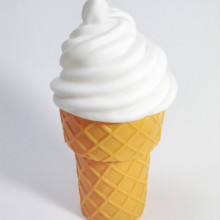
Antifreeze in Ice Cream
Ice cream is a complex structure of fats, carbohydrates and water. As the name suggests the water is in the form of ice. Really good quality smooth ice cream has very small ice crystals less than 20µm across (about a tenth of the width of a human hair). This is achieved by freezing the ice cream very quickly so the crystals don't have time to grow very large and long carbohydrate molecules are added to inhibit the crystal growth.
But as you may have noticed, if you let the ice cream warm up then refreeze it, the ice crystals grow much larger which gives an unpleasant gritty texture to the ice cream.
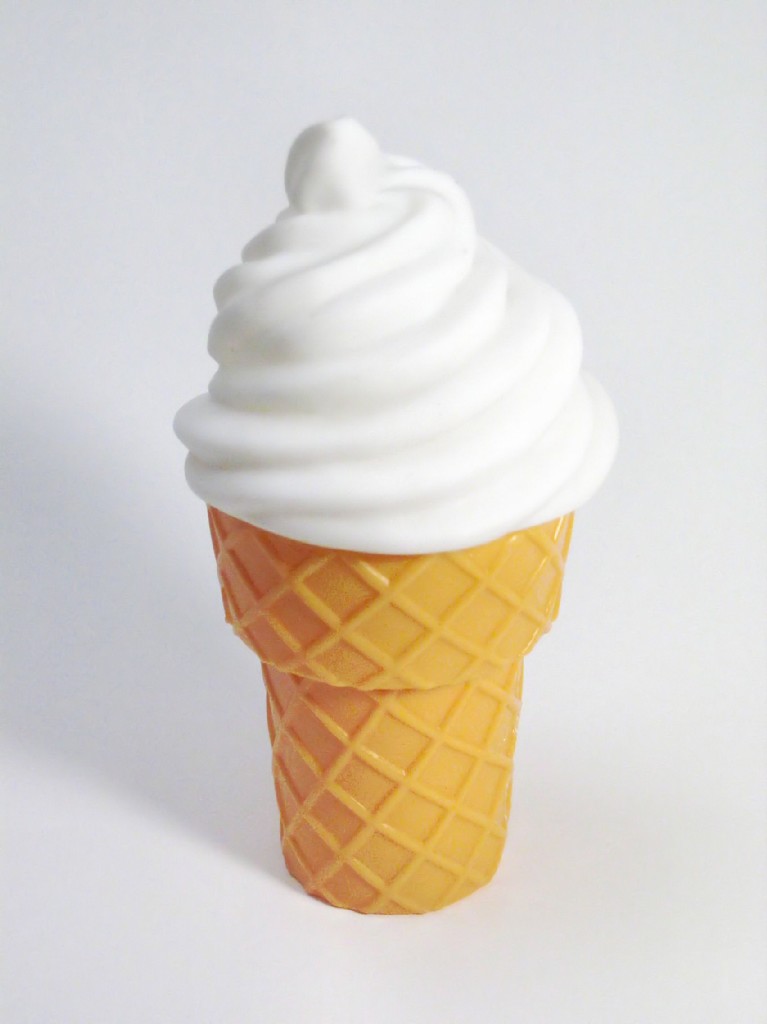 Srivassan Damodaran from the University of Madison has been working on this problem by partially digesting long gelatin molecules with an enzyme found in papaya called papin. This chops the gelatin up into short protein molecules some of which seem to interrupt the growth of the ice crystals and keep the ice cream smooth even after refreezing.
Srivassan Damodaran from the University of Madison has been working on this problem by partially digesting long gelatin molecules with an enzyme found in papaya called papin. This chops the gelatin up into short protein molecules some of which seem to interrupt the growth of the ice crystals and keep the ice cream smooth even after refreezing.
He was very interested to find out what was going on so he studied the effective protein molecules by looking at their protein sequence, and then compared this to other known proteins. It turns out that they are very similar to a natural antifreeze protein produced by an insect called the snow flea which is active all winter in northern latitudes.
Other companies have patented a form of GM yeast produced antifreeze, but this should be cheaper as it is made from a byproduct of the meat industry.
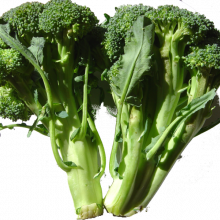
04:37 - Do Four Things, Gain Fourteen Years
Do Four Things, Gain Fourteen Years
Researchers at Cambridge University have found the secret to living fourteen years longer - don't smoke, drink moderate amounts of alcohol, take small amounts of exercise and, above all, eat your greens!
Professor Kay-Tee Khaw and her colleagues followed up 20,000 men and women aged between 45 and 71 years old who were recruited between 1994 and 1997. The study subjects filled in a simple questionnaire about their lifestyles and earned a point for every positive answer to being a non-smoker, light drinker, and regular exerciser. They also earned a point if a blood test revealed a vitamin C level consistent with eating about 5 daily portions of fruit and vegetables.
Deaths amongst the volunteers were then recorded until 2006. When they analysed the results the researchers found that, over an average period of eleven years, people who scored zero were four times more likely to die than participants who had scored four points. They also found that people scoring zero had about the same risk of dying as someone fourteen years older than them who had a score of 4 points.
So the moral of this story is quit smoking, drink in moderation, take the stairs not the lift and follow the five a day plan (that's portions of fruit and veg, not hamburgers), and you might live 14 years longer!
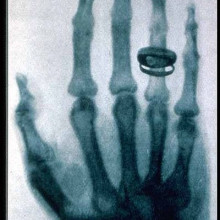
Colour X-ray Images May Help Doctors
X-ray images are traditionally in black and white, they work by sending X-rays through a patient and looking for the shadows cast by bones and tissues. Even the more modern 3D CAT (Computer Aided Tomography) scans work by combining many conventional x-rays into a 3D image, (
find out more about X-rays here.)
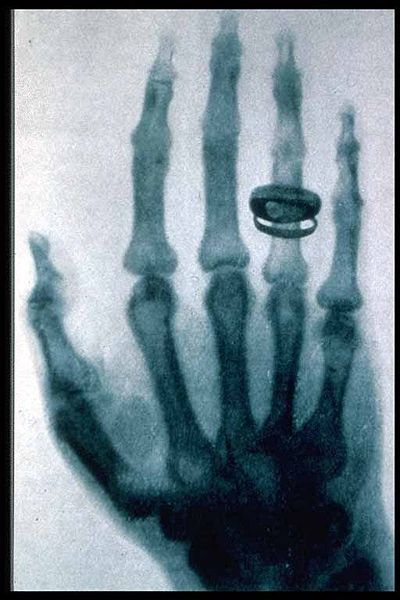 However X-rays are a form of light so they can have many different wavelengths in the same way that visible light has many different wavelengths which we call colours. Our eyes gather lots of useful information about the world from the colours of light that an object reflects, so doctors should be able to do the same with the wavelength or colour of the X-rays a tissue affects.
However X-rays are a form of light so they can have many different wavelengths in the same way that visible light has many different wavelengths which we call colours. Our eyes gather lots of useful information about the world from the colours of light that an object reflects, so doctors should be able to do the same with the wavelength or colour of the X-rays a tissue affects.
Now Robert Cernik in Manchester has built a 3D scanner that sends a mixture of wavelengths of X-rays into an object and then looks at the X-rays that bounce off the material inside the object. By moving the detector and the beam you can build up a 3D X-ray colour picture of the object.
Different tissues have different amounts of metals which interact strongly with X-rays, so the hope is that this technique will allow doctors to identify damaged tissue deep within the body without having to open you up.
However it is stil very much early days, because the sensors are not very effective at the moment it takes 3 hours to image a 5x5mm area and the radiation dose leaves it heavily damaged. However Cernik is going to try use a more sensitive form of detector that should speed the process by a factor of 100.
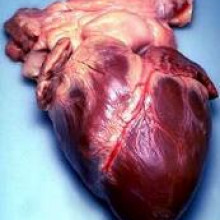
Wholehearted attempt to Repair Broken Hearts
Scientists have successfully grown a new heart in the laboratory.
 The researchers, from Harvard and the University of Minnesota, first used a process called organ decellularisation to remove all of the existing cells from the hearts of dead rats; this was achieved by perfusing the organ with a mixture of detergents which broken open and washed away the dead heart cells but left behind a scaffolding of connective tissue from which healthy new cells could be hung. The scaffolding was then bathed in a nutrient culture solution and injected with stem cells harvested from the hearts of newborn rats. Over days to weeks the stem cells divided and began to colonise the heart scaffolding, turning into new heart cells as they did so. Within eight days after the cells were injected the team could see pulsations as the developing heart cells began to beat, and the cells also responded to the administration of adrenaline-like drugs that affect the behaviour of normal heart cells.
The researchers, from Harvard and the University of Minnesota, first used a process called organ decellularisation to remove all of the existing cells from the hearts of dead rats; this was achieved by perfusing the organ with a mixture of detergents which broken open and washed away the dead heart cells but left behind a scaffolding of connective tissue from which healthy new cells could be hung. The scaffolding was then bathed in a nutrient culture solution and injected with stem cells harvested from the hearts of newborn rats. Over days to weeks the stem cells divided and began to colonise the heart scaffolding, turning into new heart cells as they did so. Within eight days after the cells were injected the team could see pulsations as the developing heart cells began to beat, and the cells also responded to the administration of adrenaline-like drugs that affect the behaviour of normal heart cells.
The researchers, led by Doris Taylor, now hope that the technique could be used to repair damaged hearts in humans.
"We used immature heart cells in this version as a proof of concept," says Taylor. "Going forward, our goal is to use a patient's stem cells to build a new heart." This would help to avoid the problems of immune rejection of donated organs.
But can the technique be scaled up from a rat to something the size of a human heart? Yes, say the researchers who have now successfully used the technique on a pig's heart, which is similar in size to our own. According to team member Harald Ott, "we just took nature's own building blocks to build a new organ."

Gas Cloud Impact
A team lead by Felix Lockman from the US National Radio Observatory have discovered that a gas cloud about 11000 light years long and 2500 light years wide will collide with our galaxy, moving at 240km/s
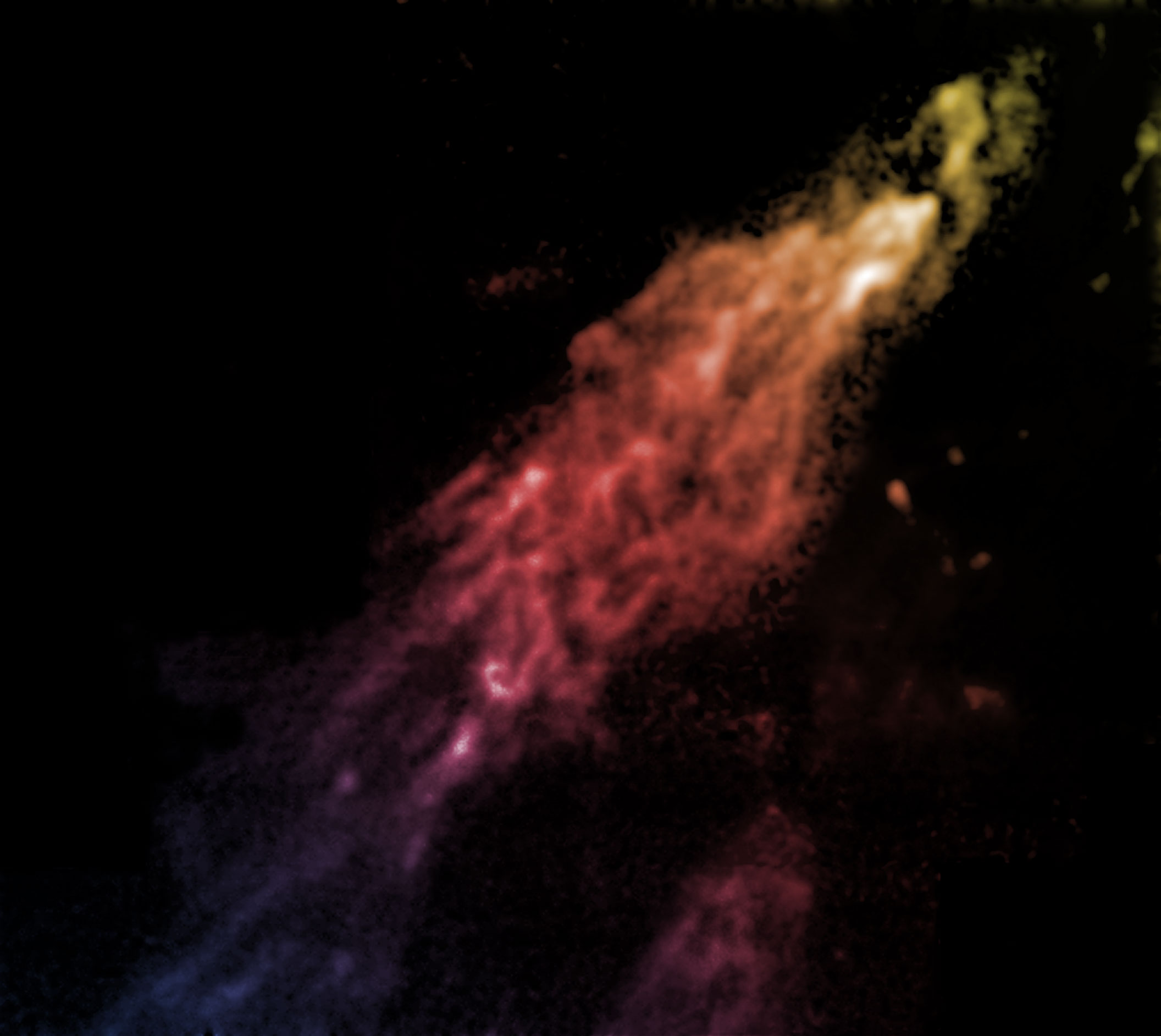 |  |
| Smith's Cloud which is on a collision course with our galaxy over the next 20-40 million years. | The predicted position of impact of the gas cloud on the milky way. |
But there is no need to worry any time soon as it is not thought to be going to hit for 20-40 million years and it will probably hit a region about 1/4 of the way around the galaxy.
When it does hit through there will be lots of cosmic fireworks as it hits the gas in the milky way forming huge hot shockwaves triggering the creation of huge numbers of stars. But if you were living in the vicinity this would not be a major problem, however when a few million years later the largest of the stars reach the end of their lives in huge explosions known as supernovae it will probably kill any life in that region of the galaxy that may or may not be there now.
Why do I always pee yellow?
The stuff that makes your pee go yellow is a chemical called urobilinogen. This is a breakdown product of the haemoglobin that makes your red blood cells red. When you have red blood cells, they're made in the bone marrow, you have millions and millions of them and you destroy something like 10^11 (100,000,000,000) of these cells every day.
When you break down the red blood cells, which have a lifespan of about 120 days, the haemoglobin molecule, responsible for binding up the oxygen and oxygenating your tissues, gets split open by chemicals called enzymes. There's a little atom of iron sat in the middle of a haemoglobin molecule. This iron is released and can be recycled in the body but the coloured molecule that used to wrap up the iron, the haemoglobin molecule, has to be broken down even further.
Once you've unwrapped the iron you have this molecule called biliverdin which is green. It then gets oxidised a bit and becomes something called bilirubin which is a brown or yellow colour. This floats around in the bloodstream and gets picked up by the liver which adds a couple more chemicals to it to make it dissolve in water. The liver then squirts it out in your bile. That's why bile is yellow [which you'll see] if you're sick: people who are having norovirus problems at the moment, 3,000,000 of them in the UK know about that only too well. The bile goes into your intestines, which are rich in bacteria. Bacteria in the intestines chop up the extra atoms and chemicals that were added to the sides of the bilirubin molecule and knock some of them off, turning it into something called urobilinogen. The urobilinogen is still yellow but it does dissolve in water. This gets reabsorbed into your intestines and some of it ends up in your bloodstream. Because it goes into water then when the blood goes through the kidneys it ends up in your urine and it comes out as a yellow colour. So that's why you have yellow urine!Some of it carries on in your intestines and bacteria change it a bit more and it turns into another molecule called stercobilin and that's brown. That's why you do brown poos!

If lightning strikes a pool you're in are you fried?
We answered this along with Robert Sullivan's question...
When lightning hits water, it suddenly dumps a huge amount of energy into the bit of water it's hitting - so very close to where it's hit it will form steam. When lightning hits sand it releases so much energy it causes sand to melt and turn into glass. It would probably vapourise the water near where it's hit and cause a bubble of steam which probably will cause a splash.
If you're swimming and lightning hits a lake it is actually very, very dangerous. If lightning hits the middle of a lake, water has got some salts in it so it will conduct electricity a bit. You would conduct electricity better. So, if you're swimming in a lake and there's a big current from the lightning strike flowing through the lake, it sees you as a kind of 'short' as it can jump 2m to an easy path. So it will flow through you.
You'd get a big current flowing through you which would be very dangerous. It can stop your heart which is why I was told in the States that you don't go swimming in a thunderstorm. The fish could end up fried as well then!
What happens when your fingers crack?
The reason you get joint cracking is because there is fluid inside your joints. When you move a joint the pressure in this fluid drops and this can cause a bubble to form made up of the gas dissolved in the liquid. The bubble pops into existence and it will take up about 15% of the space inside the joint. This causes all the little ligaments and supporting structures around the joints to pop outwards, so that's the first crack you hear. When you carry on moving the joint it goes click again as the bubble disappears. This happens when you put the pressure back up in the joint and it the bubble collapses on itself. That releases even more energy and that's the second sound that you hear. It only releases about 5% of the energy that would be able to damage cartilage, so there's no link to arthritis if you crack your joints. Although there were some interesting studies done in Germany, where they looked at someone who cracked the knuckles of their left hand for 35 years but never those of their right hand. There was no difference in arthritis but the muscles on the left hand were much weaker than the muscles on the right hand. Explain that one, if you will.

Does a cloud disperse in front of a plane?
The picture shows a plane flying through the sky with the usual contrail, the exhaust fumes of the plane, and extending in front of the plane is a very long black, thin line on the picture.I think that the sun is behind the plane and casting a shadow of the contrail. As the sun is behind the plane the shadow appears in front of the plane, as it were. The cloud is so wispy and tenuous the only way you can see it is because the sun's lighting it up. Once you're in shadow you can't see the cloud so it looks like the cloud's disappeared. Actually, if you look very closely above the contrail you can see a little bit of a shadow following above the contrail as well. I think what it is, it's just a shadow cast from an interesting direction.
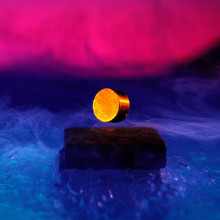
24:34 - Rising Stars - Solitons and Superconductors
Rising Stars - Solitons and Superconductors
with Ben Collie
Now The second in our series of Cambridge University's Rising Stars. These are young researchers who are telling us all about their research and how it could affect the future of all of us. This time, it's physicist Ben Collie...
The physics problems we study at school are often to do with the notion of individual objects such as a bouncing tennis ball. But to understand the world around us fully at some stage we have to consider the properties of continuous regions. For instance, suppose there's a long strip of ribbon lying flat on your desk. If you hold one end of the strip flat while you turn the other end upside down then the ribbon gets twisted and its orientation varies continuously along its length. If you start shaking one end of the strip then tension and speed of motion also vary along the ribbon's length. To describe properties that vary continuously in this way we use what physicists call a field.
A field is simply a statement of the value of a property at each point in a region. It can be the temperature at each point in a room, the water velocity at each point in a swimming pool or the orientation at each point along your ribbon. Fields are especially useful for describing the world at small scales. At small scales, matter sometimes behaves like a particle and sometimes behaves like a wave. It turns out that we can bring together these particle or wave behaviours by describing each kind of fundamental particle in terms of a field. We have an electron field, a photon field and so on. Each field fills the whole universe and takes a particular value at each point in time and space. If the field for, say, the electron has ripples or waves moving through it then, roughly speaking, this represents electrons moving through space.
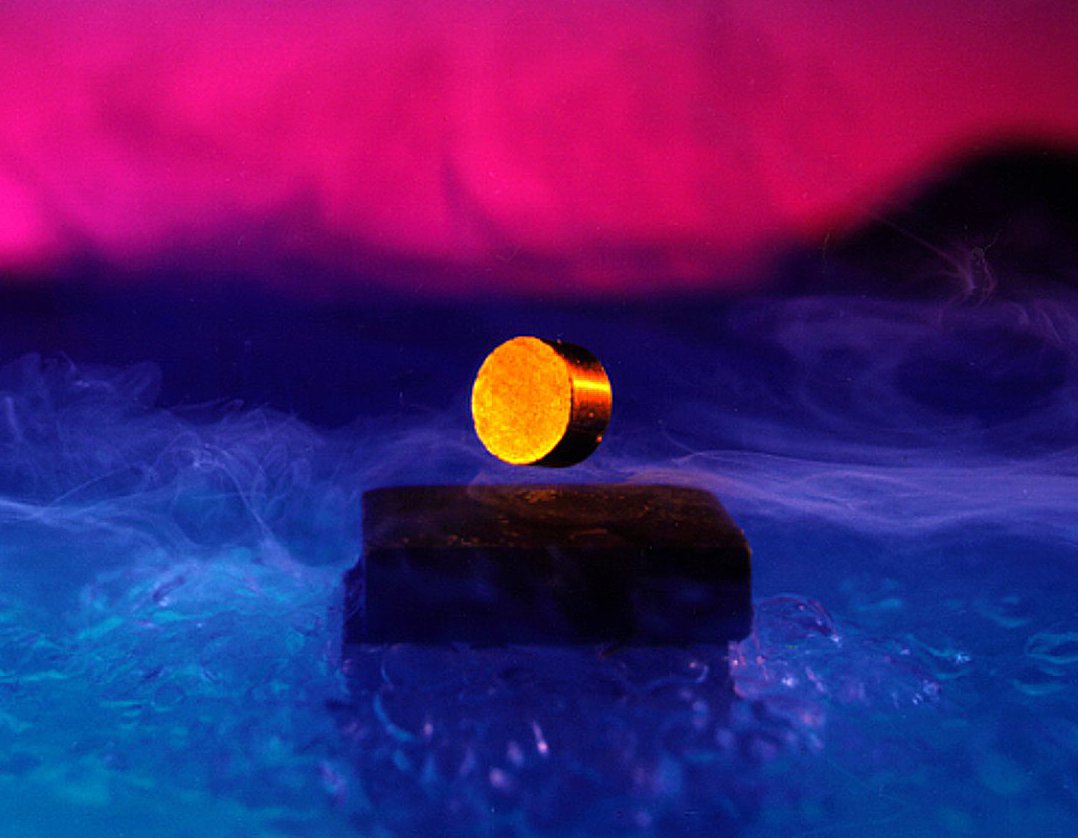 My particular research is to do with things called solitons. The name comes from the word solitary and the suffix -on which appears in the names of particles like the electron or the photon. A soliton is a certain type of disturbance in a field and solitons can occur in many different situations. For an example, think back to the long piece of ribbon on your desk. It starts off lying flat, you tape one end to the desk then turn the other end upside down and tape that end to the desk too. The resulting twist is a soliton in the ribbon's orientation field. It exists because of the different orientations of the two ends of the ribbon. You can't get rid of it without untaping one of the ends. An industrial application of solitons is in the development of superconductors: materials which have no electrical resistance at low temperatures. If you try to apply a magnetic field to a superconductor you find that a network of string-like solitons form inside it and affects the electric field. Superconductors are used in the construction of powerful electromagnets and might eventually be used to build high performance electric motors. So understanding solitons could be important for developing the technologies of the future.
My particular research is to do with things called solitons. The name comes from the word solitary and the suffix -on which appears in the names of particles like the electron or the photon. A soliton is a certain type of disturbance in a field and solitons can occur in many different situations. For an example, think back to the long piece of ribbon on your desk. It starts off lying flat, you tape one end to the desk then turn the other end upside down and tape that end to the desk too. The resulting twist is a soliton in the ribbon's orientation field. It exists because of the different orientations of the two ends of the ribbon. You can't get rid of it without untaping one of the ends. An industrial application of solitons is in the development of superconductors: materials which have no electrical resistance at low temperatures. If you try to apply a magnetic field to a superconductor you find that a network of string-like solitons form inside it and affects the electric field. Superconductors are used in the construction of powerful electromagnets and might eventually be used to build high performance electric motors. So understanding solitons could be important for developing the technologies of the future.
Is my hearing aid working?
What could be happening is the fact that you are blocking the sound that you can hear when you put your finger in your good ear suggests that your good ear is working perfectly and it's working perfectly for the normal way in which sounds are conducted into the ears: Vibrations in the air go onto your ear drum, make your ear drum move and that's turned into electrical signals in your inner ear that your brain can understand. Your hearing aid on the other side ought to be just working by amplifying the sound that you're hearing and making bigger movements in the ear on that side so that the signals that go into the inner ear and get converted into electrical signals. Even though the ear doesn't work as well, the signals from the hearing aid are so much louder it allows what hearing is there to work a bit better. The fact that your hearing is lost when you put your finger into the other ear and block off the conduction of the sound suggests that the hearing aid is just not succeeding on that side in managing to make what's left of your hearing there actually register anything that you can physically hear. I think that's the problem. I don't think the hearing aid's faulty necessarily. If it's been checked, it's been checked. I think it's possibly that your ear's not working as well as it could. There are various therapies that are in the pipeline now to help people who've lost the ability of the inner ear to detect sound and turn it into electrical signals. What scientists are now exploring is the idea of stimulating the nerves that connect the inner ear directly to the brain and you can get quite good discrimination of sounds that way. A bit like a cochlear implant but a bit more advanced.
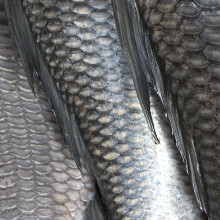
31:33 - Chemistry World - Nanonails and Fish Scales
Chemistry World - Nanonails and Fish Scales
with Mark Peplow, Chemistry World
Joining us now from the Royal Society of Chemistry: the Editor of Chemistry World, Mark Peplow.
Mark - Hello Chris.
Chris - This looks amazing. Non-stick at the flick of a switch?
Mark - Yes, it sounds fantastic doesn't it? This is a group of scientists from Bell laboratories in New Jersey in America. They've created a material that switches from sticky to non-sticky just at the flick of a switch. They've made this out of what they're calling nanonails. These are, well, very tiny nails. The head of the nail is about four hundred billionths of a metre across. That's five hundred times thinner than a human hair. A huge array of these nails which are made out of silicon, coated in a fluoropolymer that's kinda similar to what your non-stick pans are made out of. Normally, liquids are repelled by these nail heads so they bead on top but if you apply a voltage it actually changes the electrostatics of the nails and it sucks the liquid around, underneath each of the nail heads and it spreads the liquid out across the surface. Just as you would expect a liquid to normally spread out across any kind of sticky surface. As soon as you take the voltage off again the nails regain their original properties and the water beads up again. It actually works for lots and lots of different types of liquids.
Chris - Not just water?
Mark - Not just water, loads of liquids: oils, petrol, things like that.
Chris - What could you do with this? It sounds pretty amazing. What sorts of applications have been suggested for it straight away?
Mark - The scientists that have worked on it have suggested a couple of things. One is using certain types of specialised self-cleaning surfaces. At the moment what they're working on is to try and use it in very miniature labs, just the size of maybe a cm across (called labs on a chip). There are ways of processing very small amounts of material and they're working on using these surfaces to move liquid from one place to another in this little chip.
Chris - Amazing, we'll have to watch that space. It could come in handy in the kitchen as well. Take us on a trip to Paris, because you've got some interesting insights locked away in amber as to what Paris used to be like in the past.
Mark - That's right. What was Paris like 55 million years ago?
Chris - This is the city, not Paris Hilton!
Mark - Yeah. Ask a palaeontologist and they'll tell you it was probably a tropical forest. You look at the fossil record and the temperature record. It suggests that it was covered in tropical forest, surrounded by shallow seas. Chemists in Paris have found an interesting confirmation of this in amber. Amber is just fossilised tree sap. They found a piece from 55 million years ago in Paris and they've looked at some of the chemicals in it. They found a very unusual chemical that belongs to a class of compounds called diterpenes. They've looked at it and thought, 'what sort of tree chemical could this have come from?' By doing a clever bit of chemistry they've worked out that it came from an acid called iso ozic acid. This has only really been found in one type of tree before and it's an Amazon rainforest tree. They're linking this as evidence to say that whatever type of tree this fossilised resin came from it was probably a tropical tree, an ancestor of the sorts of things that we see in the Amazon today.
Chris - It was definitely growing there, this wasn't brought in from outside by various geological processes?
Mark - No, they looked at various different amber deposits from the L'Oise river which is near Paris. The tree that they're linking to is called the burandanga tree.
Chris - Sounds catchy. Talking about rivers and things, fish live in rivers and people are doing interesting things with fish scales.
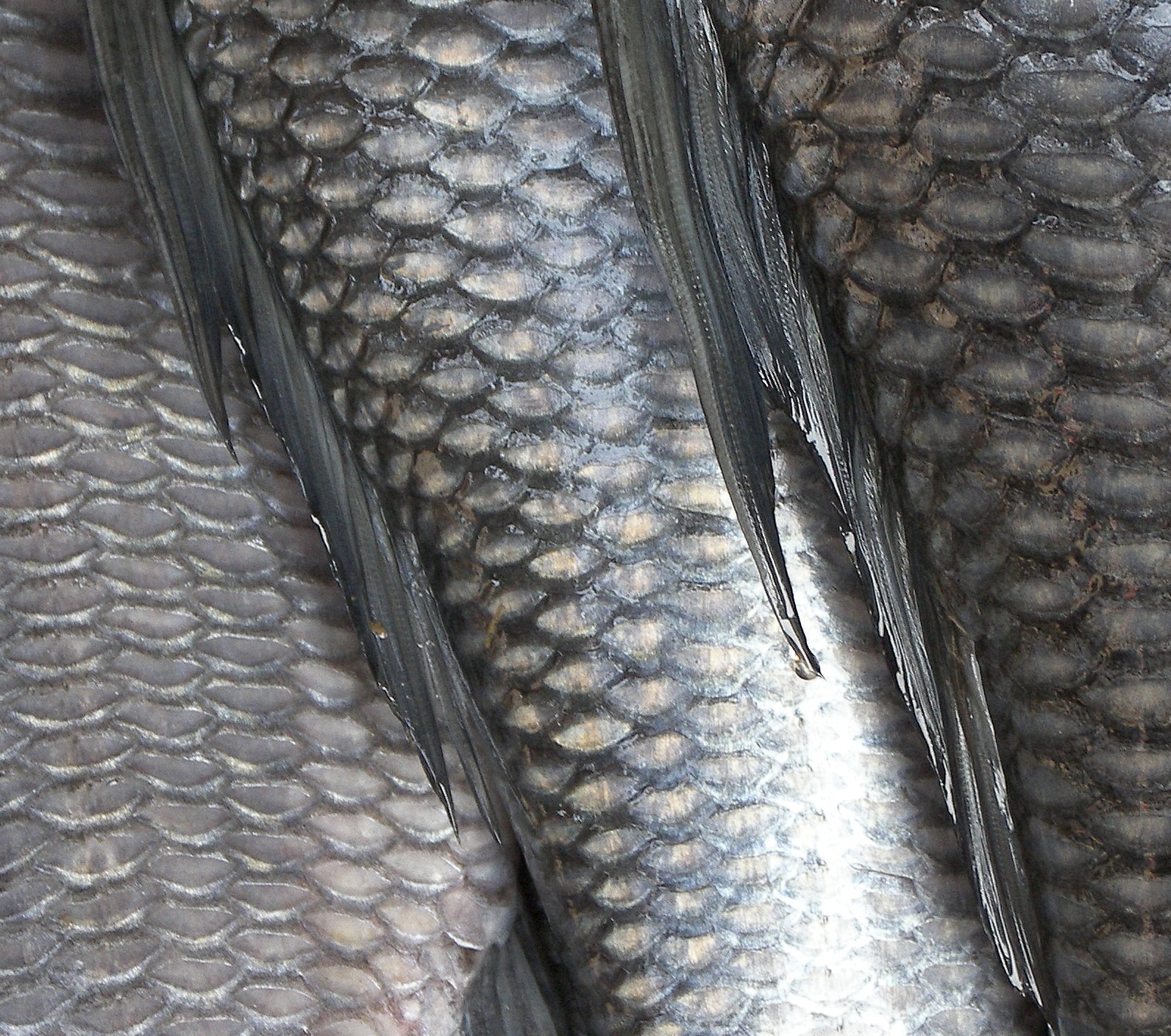 Mark - This is great. This is such a nice little story. A little bit of detective work, really. Have you ever wondered why fish scales are so shimmery? For quite a while we've known that it has something to do with the fact that the fish scales have crystals of guanine in them. Guanine is a chemical that's one of the information carrying molecules in DNA. Interestingly, scientists in Israel have pushed this story one stage further. Normally, when you grow guanine in the lab the crystals come out as a prism shape but they actually looked very closely using x-rays and electron microscopy at the guanine crystals that are found in fish scales. They found that they were very thin plates, not at all like the prisms that you'd normally get. More than that, the thin plates - the thickness and the separation of them is perfect for reflecting visible light because the thickness of it determines how good they are at reflecting certain wavelengths of light. If you look at how much energy it takes to grow certain types of crystal it's a lot easier to grow normal prism crystals in the lab.
Mark - This is great. This is such a nice little story. A little bit of detective work, really. Have you ever wondered why fish scales are so shimmery? For quite a while we've known that it has something to do with the fact that the fish scales have crystals of guanine in them. Guanine is a chemical that's one of the information carrying molecules in DNA. Interestingly, scientists in Israel have pushed this story one stage further. Normally, when you grow guanine in the lab the crystals come out as a prism shape but they actually looked very closely using x-rays and electron microscopy at the guanine crystals that are found in fish scales. They found that they were very thin plates, not at all like the prisms that you'd normally get. More than that, the thin plates - the thickness and the separation of them is perfect for reflecting visible light because the thickness of it determines how good they are at reflecting certain wavelengths of light. If you look at how much energy it takes to grow certain types of crystal it's a lot easier to grow normal prism crystals in the lab.
The fish are expending quite a lot of effort and energy to grow these very specialised forms of crystals. The team that are working on these from the Weizmann institute - they think that the fish likely has an inhibitory factor in their skin that as the crystals are growing and growing is controlling the way that those molecules stack up together. That's what they're looking for next.
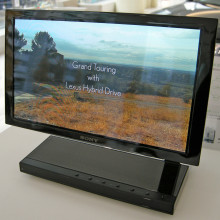
37:25 - Must Have Gadgets?
Must Have Gadgets?
with Chris Vallance
Now it's time to find out the latest from the world of technology with Meera Senthilingham and Chris Vallance.
Meera - Now, the biggest event in the gadget calendar happened this week in Las Vegas. That's the Consumer Electronics Show, where all the latest gadgets and gizmos of 2008 are on show. I had a chat with our technology expert, Chris Vallance, to find out about it. So Chris, what's the point of the Consumer Electronics Show?
Chris V - CES is really about the gadgets, it's about the electronics, it's about people showcasing their new products. The BBC's technology correspondent Rory Cellan-Jones was there. Just as he was about to leave Las Vegas I caught up with him and asked him to summarise what the event had been like.
 Rory - We're seeing the digital home really come a step closer here through a number of different devices. Just when you think digital TV has gone as far as it can go. We're all getting used to the transition from cathode ray to various kinds of flat screen technologies. Now organic LED is a new technology which, so far has been used in pretty small screens. What you get is a very slim screen, very economical in its energy use and incredibly pure colour. It's very difficult when you see them on the TV from afar to appreciate it. Actually standing in front of them the other day I was really impressed for once and thought, I'd like one of those. The trouble is at this stage, it's a very expensive technology. I think Sony's got an 11 inch screen on scale for $2500, about £1300 for a tiny, tiny TV.
Rory - We're seeing the digital home really come a step closer here through a number of different devices. Just when you think digital TV has gone as far as it can go. We're all getting used to the transition from cathode ray to various kinds of flat screen technologies. Now organic LED is a new technology which, so far has been used in pretty small screens. What you get is a very slim screen, very economical in its energy use and incredibly pure colour. It's very difficult when you see them on the TV from afar to appreciate it. Actually standing in front of them the other day I was really impressed for once and thought, I'd like one of those. The trouble is at this stage, it's a very expensive technology. I think Sony's got an 11 inch screen on scale for $2500, about £1300 for a tiny, tiny TV.
Samsung had a much bigger screen, a 30" OLED but they weren't saying when that was going to come to market and what price it would be. Generally, new kinds of television are a big theme here. Another TV which I didn't get to see but one of my colleagues was pretty impressed by was the Laser TV, a new technology developed by Mitsubishi: again promising richer, deeper colours and lower energy use. There's a big competition here to convince consumers that they do need to upgrade yet again.
Meera - So that was BBC technology correspondent Rory Cellan-Jones. Were there any other gadgets that caught your eye, Chris?
Chris V - I must admit one of the things about the CES - it's always fun to read about some of the weird and quirky inventions that people come out with. A couple of them: fashion models of Taser stun-guns. The other thing that caught my eye was an electronic picture frame. Now you can see these things in the shops all over the place where you put in your digital camera photos and they rotate the pictures, there's a slide show. There's a new take on that where there's a picture frame where you could actually add a mobile phone number so you could send the pictures to it. I must admit the evil part of my brain was thinking about all the pranks you could play. Although if somebody else you don't know or don't like finds the number it could be a bit embarrassing. There was lots of stuff on display at CES so an interesting event for those who were there. Lots and lots to be read about online, as well.
Meera - Moving on to developments online it looks like the people behind Wikipedia are trying to get into the search business, are they?
Chris V - Yes, this was quite a big announcement. Jimmy Wales, the founder of Wikipedia (he also has a commercial business called Wikia, a commercial Wikia hosting company). Wikia have launched what they're describing as an open-source search engine. It's called Search Wikia. I spoke to Jimmy Wales, the Wikia and Wikipedia founder about the new search engine and he told me what was different about it.
Jimmy - Yeah, so launching on Monday to have a brand new open-source search engine that's completely controlled by the community of users. It's going to work similar to any Wiki except people will be able to participate in the creation of search results. We're putting everything under free license so that other people can take it and modify it and adapt it. There's many different ways that people can tweak search results. People could on a very basic level give some kind of feedback i.e. 1-5 stars on search results to give feedback into the algorithm. It's very similar to Wikipedia in the sense that the community are given control over the editorial decisions.
Chris V - That was Jimmy Wales, Wikipedia founder. Also the person who's behind Search Wikia, the new open source search engine.
Meera - Chris, what do you think's going to set this apart from other search engines?
Chris V - The important thing is that the search algorithms, the thing that determines what comes out top when you type in a search term: that's all going to be open. That's a very different approach from search engines like Google which tend to very closely guard the exact rules that determine what comes out top of the list when you type in 'soft cheese'. Search Wikia's approach is very different, they're saying, 'let's open it all up, let's make everything transparent.' That has positive effects in that you can see what's going on and why things are happening but there are other issues as that arise: conflicts of interest from the people developing the search algorithm. What happens if companies say, 'oh well, that's how it works so that's how we get our results further up the list.' It's a really different approach. I guess at the end the proof will be in the pudding. Which search engine users decide gives them the best results. It will be interesting to see how it develops as Search Wikia grows.
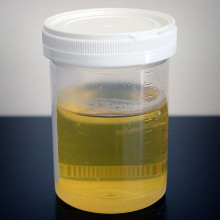
What should the colour of a healthy person's urine be?
The answer is it's all down to concentration. The more you drink the more dilute your urine is and therefore the more dilute any colourants (the urobilinogen) that's being made and filtered from the bloodstream into it. If you haven't drunk very much you continue to break down red blood cells and produce this urobilinogen and therefore you will have urine which tends to be a darker colour. Conversely if you drink a lot, it'll dilute it and the urine goes a lighter colour. There is an exception to this which is that if you have a problem with the bile flowing out of the liver because you have gallstones, for example, then the bilirubin that is the thing that produces this urobilinogen in the first place can't get out of the body and therefore you have a build-up in the bloodstream and this can end up producing a dark urine. You get very, very dark urine under those circumstances.
Why is it that sometimes when you wee it goes frothy?
The thing that makes that happen is protein. Sometimes, if you have certain problems with the kidneys you can produce very frothy urine: it's almost like champagne. You get this massive head on the urine. That's a serious problem but the day-to-day occasional frothiness is just because occasionally there's more protein in your urine than others. The protein breaks down the surface tension of water and you get these bubbles forming. It acts a bit like bubble bath which is why you get the fizz.
What matter in the original atom bomb is converted to energy?
If you take a proton or something and make it go really, really fast - give it lots of kinetic energy then relativity says it gets heavier. In the same way if you've got lots of potential energy if you put it into a really big heavy atom like uranium then it will also get heavier. When you split up that big atom you get less potential energy and that means that the resultants (all of the protons and all of the neutrons inside) are lighter than they were before because they have less potential energy. So there are actually the same number of constituents, but the sum total weight is decreased.
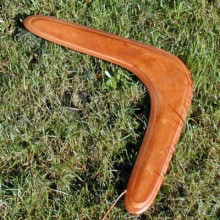
45:46 - Boomerang Physics?
Boomerang Physics?
This question was answered by Dr Hugh Hunt, Dept. Engineering, Cambridge University:
That's a really good question. A boomerang goes around on more or less a circular path. The motion is really just fantastic. It's a combination of various physical principles for example, aerodynamic lift and circular motion. You've got to get these physical principles just right when you throw the boomerang which explains why boomerangs are a bit tricky to throw. Think of the two arms of the boomerang as being just like the wings of an aeroplane. The faster they move through the air, the more lift they generate. Unlike an aeroplane a boomerang spins as it moves through the air and the combination of spin and forward speed means that some parts of the boomerang are moving faster than others. This means that the aerodynamic lift is not uniform over all parts of the boomerang. The wings of an aeroplane are horizontal so the lift is upwards. The wings of a boomerang are sideways so the net lift is towards the centre of the circle that you see the boomerang move on.
There's one more important physical principle. The non-uniform lift generates torque or a moment, a twisting force - whatever you like to call it and this causes the gyroscopic effect to come into play. A spinning boomerang is really no different to a spinning gyroscope and the gyroscopic effect makes the boomerang turn around nicely, at just the right rate. It really is magical and the best bit of all this is that the entire explanation rests on Newton's laws of motion.
There's one more little catch, and that's to do with gravity. You need a bit of lift force directed upwards. Otherwise the boomerang will just drop down to the ground in no time. This explains why you need to throw a boomerang with a little bit of a tilt. It also explains why a good boomerang will increase its tilt angle as it slows down. This is called laying over. The boomerang that has slowed down and laid over is really easy to catch.
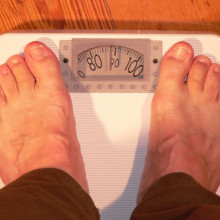
Do you weigh less at the equator than at the poles?
Yes, you do weigh a bit less at the equator than at the poles.
Although your mass is the same, so that you've got the same amount of fat - the same amount of "you", when you're at the equator you're spinning round so you're getting thrown away from the Earth due to the centrifugal force (the same force you've experienced if you've ever sat on a roundabout and, when it spins around, you can feel yourself being pushed away from the centre).
And, in fact, you're actually lighter than even the centrifugal force can account for, because the Earth "bulges out" at the equator, so you're further from the centre of the Earth. Since gravity acts through a body's center of mass, the further you are from the centre the weaker the gravitational acceleration you will feel, because gravity weakens over distance.
So even if the Earth wasn't spinning, you're actually lighter at the equator than you'd be at the poles.
How much less do I weigh when the moon is directly overhead?
We calculated it's something like 0.48g lighter for a 100kg person. They're gonna be about 0.5g lighter when the moon is directly overhead because the moon is attracting you in the same way it attracts water when it makes tides.
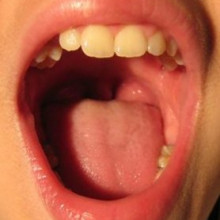
Where does saliva come from?
Saliva is made in the same way that you make tears.
You have glands, which have a rich blood supply. When the blood goes through it passes through very thin-walled capillaries, which are a little bit leaky. It's exactly the same as if you go to the garden centre and you see those watering systems where the pipes have small holes in them. You turn the tap on and the water going through squeezes some of the water out of the pipe.
Why do you make saliva, in other words watery liquid and not blood? The answer is the walls of these tiny capillaries are just big enough for water molecules but they're too small to let the bigger proteins and cellular components of blood leach out. Some things can get out: the water, and some antibodies but that's about it.
Saliva also stops viruses because it contains antibodies. It's got an antibody called IgA which is one of the immunoglobulins which can neutralise viruses. Yes you can mop up a lot of colds and viruses and bacteria with the constituents of saliva. The antibody is secreted - you actually have a pump which pushes them into the saliva. They're added after you've made the saliva or tears.
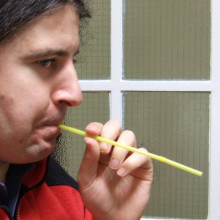









Comments
Add a comment